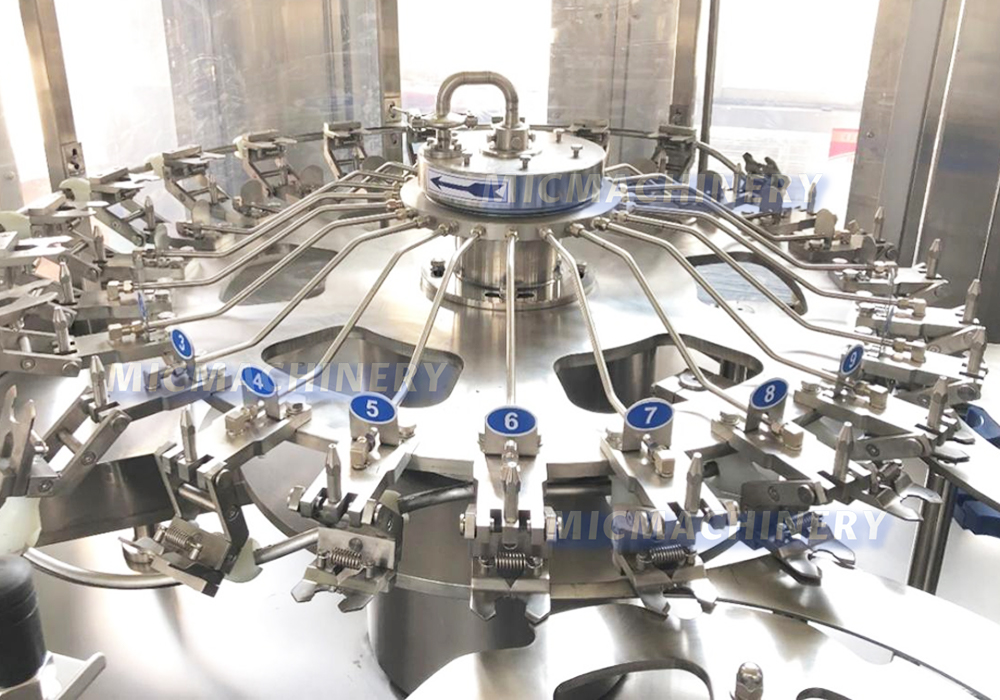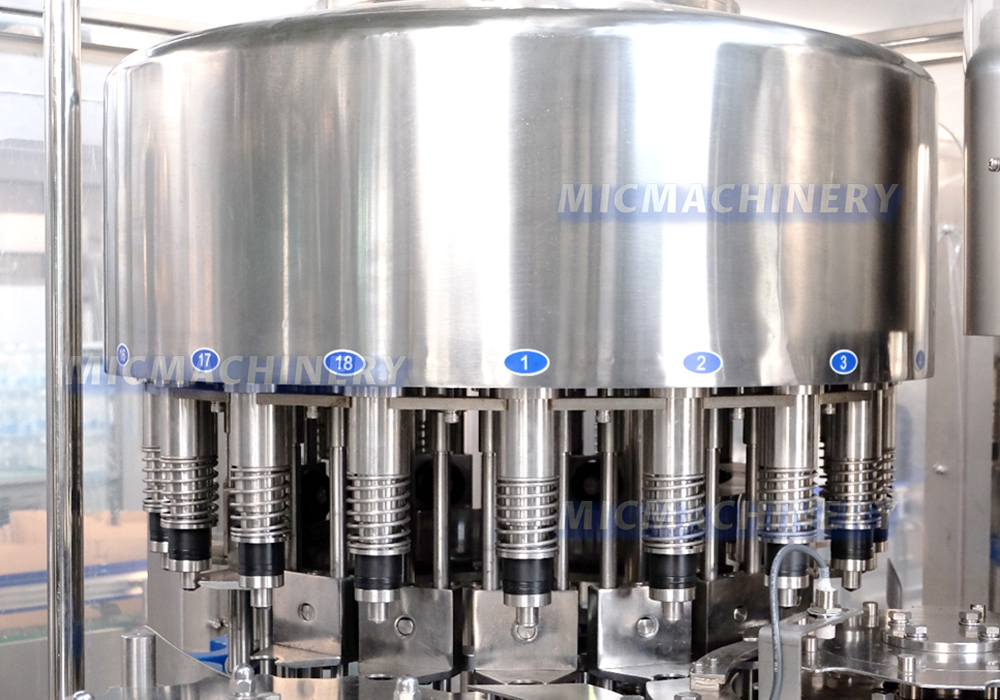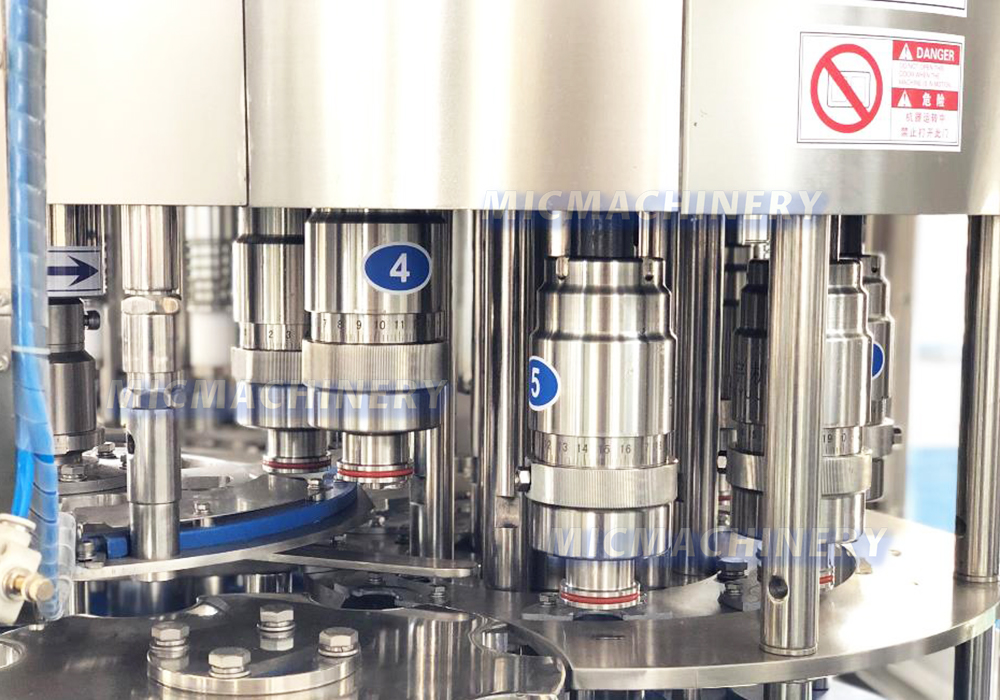- E-mail: sales8@micmachinery.com
- Mobile: 0086-13083991987
- Whatsapp: 0086-13083991987
- Wechat: 0086-13083991987
- Shipment: exporting country
- Customer reviews: click on
1) Bottle is entered by air conveyor, the speed of bottle entering is fast and bottle shape isn’t changed because of adopting hanging clamping bottleneck way
2) Adopting clamping bottleneck way to wash bottle mouth and avoid touching screw mouth, adopting clamping bottleneck way in the whole conveying process. When bottle type changes, you need to change the board related with bottle diameter
3) Filling adopts cylinder feeding structure, filling valve adopts high filling speed and mass flow rate valve which control liquids level accurately and without loss.
4) Screw capper adopts French advanced technology which cans screw cap promptly when clamping bottle.
5) The PLC and transducer are chosen from international famous brand, such as OMRON, MITSUBISHI.
A juice filling line typically consists of multiple components and stations that work together seamlessly to carry out the entire filling process. These components may include bottle or container rinsing machines, filling machines, capping machines, labeling machines, and conveyor systems.
The first step in a juice filling line is the bottle or container rinsing station. This station cleans and sanitizes the bottles or containers before they are filled with juice. It ensures that the packaging is free from any contaminants or residues that may affect the quality of the juice.
Next, the bottles or containers move to the filling station, where the juice is accurately dispensed into each one. The filling machine is designed to handle different bottle sizes and fill volumes, ensuring precise and consistent filling. It may employ advanced technologies such as volumetric or gravimetric filling methods to achieve accurate measurements.
After the filling process, the bottles or containers proceed to the capping station, where secure closures are applied to seal the juice inside. This station may include different types of capping machines depending on the closure type, such as screw caps, snap caps, or corking systems.
The final stage in a juice filling line is the labeling station. Here, labels or codes are applied to the bottles or containers for identification, branding, and regulatory compliance purposes. The labeling machine can handle various label types, such as pressure-sensitive labels or shrink sleeves, and may include additional features such as date coding or batch numbering.
Throughout the entire juice filling line, conveyor systems are used to transport the bottles or containers from one station to another in a continuous and synchronized manner. These conveyors ensure smooth and efficient movement, minimizing downtime and optimizing production output.
The benefits of using a juice filling line include increased production efficiency, reduced labor costs, precise filling accuracy, improved product quality, and enhanced safety and hygiene. By automating the filling process, the line minimizes human errors, reduces the risk of contamination, and ensures consistent and reliable results.
In summary, a juice filling line is a comprehensive solution for automating the juice filling process. It integrates various machines and components to create a seamless production system, from bottle rinsing to filling, capping, and labeling. The use of a juice filling line enhances productivity, product integrity, and overall operational efficiency for manufacturers in the food and beverage industry.

Washing Part
Washing part is mainly composed of washing pump, bottle clamps, water distributor, up turn-plate, guide rail, protection cover, spraying device, defrosting tray, rinse water take and rinse water refluxing tank.The bottle is turned upside down and centered above a spraying nozzle which directs a stream of rinse water into the bottle. After the draining period the bottle is turned over to an upright position again.

Filling Part
Filling part is mainly composed of liquid tank, filling valve, bottle hanging device / bottle pedestals, guide rail, elevating device, liquid indicator, pressure gauge, pressure regulator, etc.
Filling valves are made of SUS304. Filling valves are reasonably structured with accurate filling. Bottles go up and down in the function of cam through elevator, to process filling with contact to bottle-mouth.

Capping Part
- Place and capping system, electromagnetic capping heads, with burden discharge function, make sure minimum bottle crash during capping
- All 304/316 stainless steel construction
- No bottle no capping
- Automatic stop when lack of bottle
- Capping effect is stable and reliable,Defective rate ≤0.2%

|
Model |
8-8-3 |
14-12-5 |
18-18-6 |
|
Application |
Juice, tea, pure water, mineral water, energy drinks, coffee and etc. |
||
|
Filling Way |
Gravity Filling |
||
|
Packing Type |
PET/Plastic bottle |
||
|
Production Capacity |
2000-2500BPH |
3000-5000BPH |
5000-8000BPH |
|
Powder |
1.2KW |
1.5KW |
2.2KW |
|
Weight |
1500KG |
2000KG |
4000KG |
|
Overall Dimensions(mm) |
2260*1600*2600 |
2250*1650*2650 |
2850*2150*2700 |
|
No. |
Name of parts |
Brand |
|
1 |
PLC |
Mitsubishi Japan |
|
2 |
Touch screen |
WEINVIEW |
|
3 |
Inverter |
Siemens Germany |
|
4 |
Low-voltage apparatus |
Schneider France |
|
5 |
Pneumatic components |
AirTAC Taiwan |
|
6 |
Bearing |
China |
|
7 |
Optical sensor |
Omron Japan |
- Beer Filling Machine
- Juice Filling Machine
- Soda Filling Machine
- Drink Filling Machine
- Carbonated Soft Drink Filling Machine
- Beverage Filling Machine
-
Labeling Machine
- Round Bottle Labeling Machine
- Shrink Sleeve Labeling Machines
- Shrink Sleeve Machine Shrink Label Machine
- Shrink Sleeve Applicator Packaging Machine
- Can Sleeving Machine
- Shrink Sleeve Packaging Machines
- Hot Melt Glue Labeling Machine
- Self Adhesive Labeling Machine
- Laser Coding Machine
- Other Types Of Labeling Machines
-
Packing Machine
- Wrap Packing Machine
- Case Packing Machine
- Blow-drying Machine
- Depalletizer
- Carbonated Drink Mixing Machine
- Pasteurization Machine
- Liquid Nitrogen Dosing Machine
- X-Ray Liquid Level Detection Machine
- Weight Detector
- Metal Detector Food Industry
- Aseptic Liquid Nitrogen Dosing Machine
- Palletizer
- Pallet Wrapping Machine
- Bottle Blowing Machine
- Semi Auto Bottle Blowing Machine
-
Beer Beverage Filling Machine
- Can filling machine
- Glass bottle filling machine
- Pet bottle filling machine
- Beer Filling Machine
- Beer Can Filling Machine
- Beer Bottle Filling Machine
- Semi Automatic Beer Filling Machine
- Soda Filling Machine
- Soda Bottling Machine
- Juice Filling Machine
- Juice Can Filling Machine
- Beverage Filling Machine
- Carbonated Drink Filling Machine
- Edible Oil Filling Machine
- Water Filling Machine
- Aseptic Cold Filling Machine
- Blowing Filling Capping Machine
- Beverage Processing Equipment
- Auxiliary equipment
- Beer Filling Machine
- Juice Filling Machine
- Soda Filling Machine
- Drink Filling Machine
- Carbonated Soft Drink Filling Machine
- Beverage Filling Machine
-
Labeling Machine
- Round Bottle Labeling Machine
- Shrink Sleeve Labeling Machines
- Shrink Sleeve Machine Shrink Label Machine
- Shrink Sleeve Applicator Packaging Machine
- Can Sleeving Machine
- Shrink Sleeve Packaging Machines
- Hot Melt Glue Labeling Machine
- Self Adhesive Labeling Machine
- Laser Coding Machine
- Other Types Of Labeling Machines
- Round Bottle Labeling Machine
-
Packing Machine
- Wrap Packing Machine
- Case Packing Machine
- Blow-drying Machine
- Depalletizer
- Carbonated Drink Mixing Machine
- Pasteurization Machine
- Liquid Nitrogen Dosing Machine
- X-Ray Liquid Level Detection Machine
- Weight Detector
- Metal Detector Food Industry
- Aseptic Liquid Nitrogen Dosing Machine
- Palletizer
- Pallet Wrapping Machine
- Bottle Blowing Machine
- Semi Auto Bottle Blowing Machine
- Wrap Packing Machine
-
Beer Beverage Filling Machine
- Can filling machine
- Glass bottle filling machine
- Pet bottle filling machine
- Beer Filling Machine
- Beer Can Filling Machine
- Beer Bottle Filling Machine
- Semi Automatic Beer Filling Machine
- Soda Filling Machine
- Soda Bottling Machine
- Juice Filling Machine
- Juice Can Filling Machine
- Beverage Filling Machine
- Carbonated Drink Filling Machine
- Edible Oil Filling Machine
- Water Filling Machine
- Aseptic Cold Filling Machine
- Blowing Filling Capping Machine
- Can filling machine
- Beverage Processing Equipment
-
Auxiliary equipment




